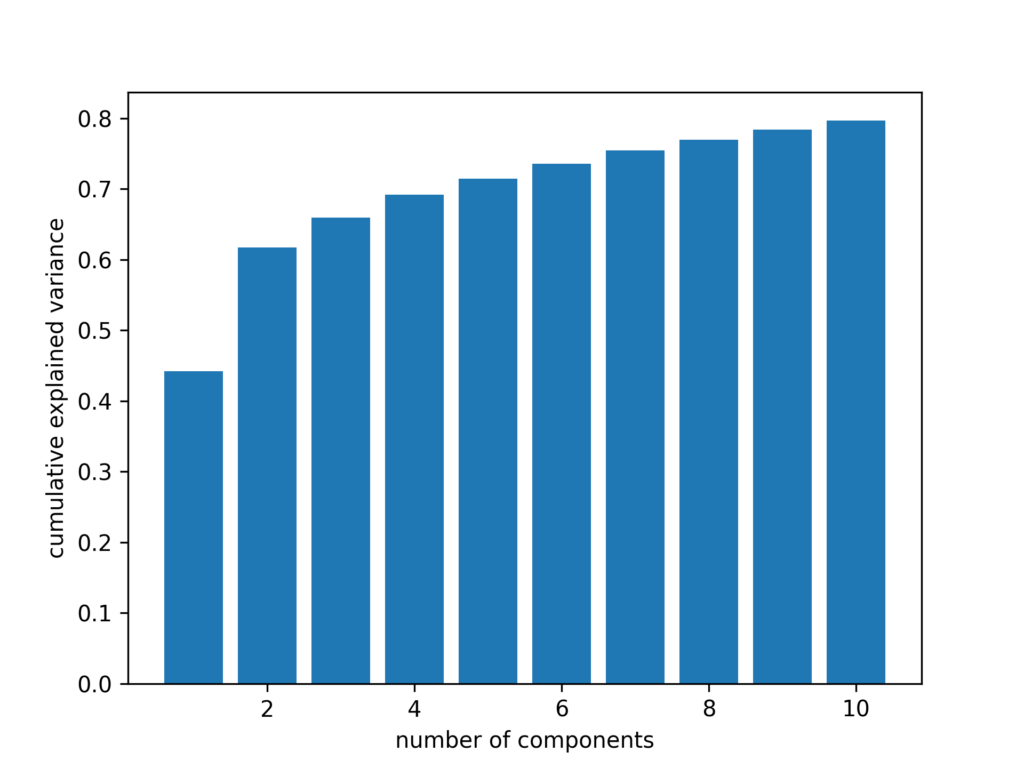How Principal Are Your Components?
This post is an offshoot from Chapter 1 of Probably Overthinking It, which is available for pre-order now!
In a previous post I explored the correlations between measurements in the ANSUR-II dataset, which includes 93 measurements from a sample of U.S. military personnel. I found that measurements of the head were weakly correlated with measurements from other parts of the body – and in particular the protrusion of the ears is almost entirely uncorrelated with anything else.
A friend of mine, and co-developer of the Modeling and Simulation class I taught at Olin, asked whether I had tried running principal component analysis (PCA). I had not, but now I have. Let’s look at the results.
Click here to run this notebook on Colab.
The ANSUR data is available from The OPEN Design Lab.
Explained Variance
Here’s a visualization of explained variance versus number of components.

With one component, we can capture 44% of the variation in the measurements. With two components, we’re up to 62%. After that, the gains are smaller (as we expect), but with 10 measurements, we get up to 78%.
Loadings
Looking at the loadings, we can see which measurements contribute the most to each of the components, so we can get a sense of which characteristics each component captures.
I won’t explain all of the measurements, but if there are any you are curious about, you can look them up in The Measurer’s Handbook, which includes details on “sampling strategy and measuring techniques” as well as descriptions and diagrams of the landmarks and measurements between them.
Principal Component 1: 0.135 suprasternaleheight 0.134 cervicaleheight 0.134 buttockkneelength 0.134 acromialheight 0.133 kneeheightsitting Principal Component 2: 0.166 waistcircumference -0.163 poplitealheight 0.163 abdominalextensiondepthsitting 0.161 waistdepth 0.159 buttockdepth Principal Component 3: 0.338 elbowrestheight 0.31 eyeheightsitting 0.307 sittingheight 0.228 waistfrontlengthsitting -0.225 heelbreadth Principal Component 4: 0.247 balloffootcircumference 0.232 bimalleolarbreadth 0.22 footbreadthhorizontal 0.218 handbreadth 0.212 sittingheight Principal Component 5: 0.319 interscyeii 0.292 biacromialbreadth 0.275 shoulderlength 0.273 interscyei 0.184 shouldercircumference Principal Component 6: -0.34 headcircumference -0.321 headbreadth 0.316 shoulderlength -0.277 tragiontopofhead -0.262 interpupillarybreadth Principal Component 7: 0.374 crotchlengthposterioromphalion -0.321 earbreadth -0.298 earlength -0.284 waistbacklength 0.253 crotchlengthomphalion Principal Component 8: 0.472 earprotrusion 0.346 earlength 0.215 crotchlengthposterioromphalion -0.202 wristheight 0.195 overheadfingertipreachsitting Principal Component 9: -0.299 tragiontopofhead 0.294 crotchlengthposterioromphalion -0.253 bicristalbreadth -0.228 shoulderlength 0.189 neckcircumferencebase Principal Component 10: 0.406 earbreadth 0.356 earprotrusion -0.269 waistfrontlengthsitting 0.239 earlength -0.228 waistbacklength
Here’s my interpretation of the first few components.
- Not surprisingly, the first component is loaded with measurements of height. If you want to predict someone’s measurements, and can only use one number, choose height.
- The second component is loaded with measurements of girth. No surprises so far.
- The third component seems to capture torso length. That makes sense — once you know how tall someone is, it helps to know how that height is split between torso and legs.
- The fourth component seems to capture hand and foot size (with sitting height thrown in just to remind us that PCA is not obligated to find components that align perfectly with the axes we expect).
- Component 5 is all about the shoulders.
- Component 6 is mostly about the head.
After that, things are not so neat. But two things are worth noting:
- Component 7 is mostly related to the dimensions of the pelvis, but…
- Components 7, 8, and 10 are surprisingly loaded up with ear measurements.
As we saw in the previous article, there seems to be something special about ears. Once you have exhausted the information carried by the most obvious measurements, the dimensions of the ear seem to be strangely salient.